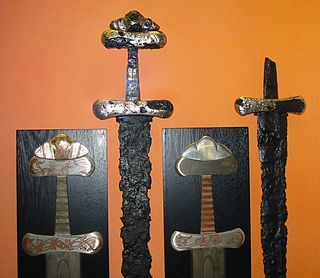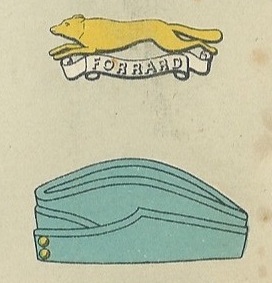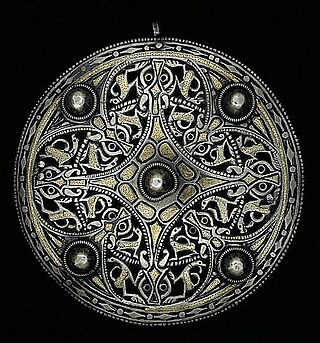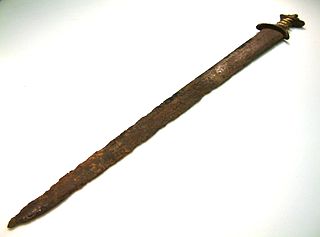Related Research Articles
A sword is an edged, bladed weapon intended for manual cutting or thrusting. Its blade, longer than a knife or dagger, is attached to a hilt and can be straight or curved. A thrusting sword tends to have a straighter blade with a pointed tip. A slashing sword is more likely to be curved and to have a sharpened cutting edge on one or both sides of the blade. Many swords are designed for both thrusting and slashing. The precise definition of a sword varies by historical epoch and geographic region.

John Robert Mortimer was an English corn-merchant and archaeologist who lived in Driffield, East Riding of Yorkshire.

Bronze Age swords appeared from around the 17th century BC, in the Black Sea and Aegean regions, as a further development of the dagger. They were replaced by iron swords during the early part of the 1st millennium BC.

The Viking Age sword or Carolingian sword is the type of sword prevalent in Western and Northern Europe during the Early Middle Ages.

Grim's Ditch, Grim's Dyke or Grim's Bank is a name shared by a number of prehistoric bank and ditch linear earthworks across England. They are of different dates and may have had different functions.

Stanwick Iron Age Fortifications, a huge Iron Age hill fort, sometimes but not always considered an oppidum, comprising over 9 kilometres (5.6 mi) of ditches and ramparts enclosing approximately 300 hectares of land, are situated in Richmondshire, North Yorkshire, England. Whether Stanwick was the stronghold of Venutius or Cartimandua, or perhaps of them both for a brief time before their acrimonious split some time after 51 AD, it is certain that this settlement was one of the most important in Brigantia, the Brigantes kingdom during the early stages of the Roman occupation of Britain. The site is a scheduled monument.
Below are notable events in archaeology that occurred in 1951.

North Grimston is a village in the civil parish of Birdsall, in North Yorkshire, England. It is situated between Norton-on-Derwent and Wharram-le-Street on the B1248 road. In 1931 the parish had a population of 143. On 1 April 1935 the parish was abolished and merged with Birdsall.

The Cawood sword is a medieval sword discovered in the River Ouse near Cawood in North Yorkshire in the late 19th century. The blade is of Oakeshott type XII and has inscriptions on both sides. It most likely dates to the early 12th century.

The East Riding of Yorkshire Yeomanry was a unit of the British Army formed in 1902. Units of Yeomanry Cavalry were raised in the East Riding of Yorkshire in the 18th and early 19th centuries at times of national emergency: the Jacobite Rising of 1745, the French Revolutionary Wars and the Napoleonic Wars. These were stood down once each emergency was over. The East Riding of Yorkshire Yeomanry, was established in 1902, and this saw action during the First World War both in the mounted role and as machine gunners.

Cawthorne Camp is a Roman site in north-east England, about 4 miles (6 km) north of Pickering, North Yorkshire. The well-preserved earthworks outline two forts, one with an extension, and a temporary camp built to an unusual plan. The earthworks date from the late 1st/early 2nd century AD. It has been suggested that they were built for practice rather than for actual military use.
The Oxborough Dirk is a large ceremonial weapon or dirk from the Middle Bronze Age. One of only six such objects across Europe, it was found in a rural part of the county of Norfolk, England in the 1980s and is now part of the British Museum's prehistoric collection.

The basket-hilted sword is a sword type of the early modern era characterised by a basket-shaped guard that protects the hand. The basket hilt is a development of the quillons added to swords' crossguards since the Late Middle Ages. In modern times, this variety of sword is also sometimes referred to as the broadsword.

The Abingdon Sword is a late Anglo-Saxon iron sword and hilt believed to be from the late 9th or early 10th century; only the first few inches of the blade remain attached to the hilt.

Danes Graves is an archaeological site in the East Riding of Yorkshire. It forms part of the Arras Culture of inhumation and chariot burial prevalent in the region during the British Iron Age. It is a prehistoric cemetery site situated in Danesdale – a dry river valley with gravel and chalk deposits. The site is north of Driffield near the village of Kilham.

Trewhiddle style is a distinctive style in Anglo-Saxon art that takes its name from the Trewhiddle Hoard, discovered in Trewhiddle, Cornwall in 1770. Trewhiddle ornamentation includes the use of silver, niello inlay, and zoomorphic, plant and geometric designs, often interlaced and intricately carved into small panels. It was primarily used to decorate metalwork. During the late Anglo-Saxon era, silver was the precious metal most commonly used to create Trewhiddle style jewellery and to decorate weapons. Famous examples include the Pentney Hoard, the Abingdon sword, the Fuller brooch, and the Strickland brooch.

The Bedale Hoard is a hoard of forty-eight silver and gold items dating from the late 9th to early 10th centuries AD and includes necklaces, arm-bands, a sword pommel, hacksilver and ingots. It was discovered on 22 May 2012 in a field near Bedale, North Yorkshire, by metal detectorists, and reported via the Portable Antiquities Scheme. Following a successful public funding campaign, the hoard was acquired by the Yorkshire Museum for £50,000.
The Kirkburn Burial is an Iron Age warrior burial dating from 250 BC–160 BC, discovered at Kirkburn, in the East Riding of Yorkshire, England. The burial was uncovered in an archaeological dig in 1987.

The Hull and East Riding Museum of Archaeology is located in the Museums Quarter of the Old Town in Kingston upon Hull, England. It dates back to 1925 as the Museum of Commerce and Industry in a former Customs House but acquired its present name in 1989 with a major refurbishment and new entrance, with the transport section moving to a separate museum. It displays items from prehistoric to medieval in the area, many of them in life-size tableaux or reconstructions of rooms and buildings.

The Gilling sword is an Anglo-Saxon sword, dating from the late 9th to early 10th centuries AD, found by a schoolboy in a river in 1976 and subsequently acquired by the Yorkshire Museum.
References
- 1 2 "North Grimston Sword". Humber Museums Partnership. Retrieved 27 February 2023.
- ↑ Mortimer, J. R. (1905). Forty years' researches in British and Saxon burial mounds of East Yorkshire, including Romano-British discoveries, and a description of the ancient entrenchments on a section of the Yorkshire wolds. p. 83.
- ↑ Piggot, Stuart (1950). "Swords and Scabbards of the British Early Iron Age". Proceedings of the Prehistoric Society. 16: 1–28.